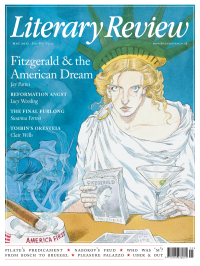Jerry Brotton
‘The Play’s the Thing’
Discussion of the impact of digital technology on books has been largely confined to hysterical pronouncements about the death of the printed book, but we might be looking in the wrong direction. It’s now clear that e-books and Kindles will not see off physical books any time soon. Last year 360 million printed books were sold in the UK, an increase of 2 per cent on the previous year. By contrast, e-book sales declined by 4 per cent. If the virtual book revolution is looking like the dog that failed to bark, there is digital bite elsewhere. Over the last two decades, the tools of digital data analysis have been grasped enthusiastically by literary scholars. The result has been a quiet revolution in book history that has not only changed the way we interpret texts but also altered our understanding of how books have been made, published and read, and of the ways in which the role of the author has evolved over time.
Nowhere has this digital revolution been more far-reaching than in the understanding of Shakespeare. Anyone working in Shakespeare studies will turn to digital resources to uncover Shakespeare’s ‘paratexts’ – the patrons, printers and editors involved in publishing his plays, their prefaces, commentaries, title pages, illustrations, even the typography and paper

Sign Up to our newsletter
Receive free articles, highlights from the archive, news, details of prizes, and much more.@Lit_Review
Follow Literary Review on Twitter
Twitter Feed
It wasn’t until 1825 that Pepys’s diary became available for the first time. How it was eventually decrypted and published is a story of subterfuge and duplicity.
Kate Loveman tells the tale.
Kate Loveman - Publishing Pepys
Kate Loveman: Publishing Pepys
literaryreview.co.uk
Arthur Christopher Benson was a pillar of the Edwardian establishment. He was supremely well connected. As his newly published diaries reveal, he was also riotously indiscreet.
Piers Brendon compares Benson’s journals to others from the 20th century.
Piers Brendon - Land of Dopes & Tories
Piers Brendon: Land of Dopes & Tories - The Benson Diaries: Selections from the Diary of Arthur Christopher Benson by Eamon Duffy & Ronald Hyam (edd)
literaryreview.co.uk
Of the siblings Gwen and Augustus John, it is Augustus who has commanded most attention from collectors and connoisseurs.
Was he really the finer artist, asks Tanya Harrod, or is it time Gwen emerged from her brother’s shadow?
Tanya Harrod - Cut from the Same Canvas
Tanya Harrod: Cut from the Same Canvas - Artists, Siblings, Visionaries: The Lives and Loves of Gwen and Augustus John by Judith Mackrell
literaryreview.co.uk